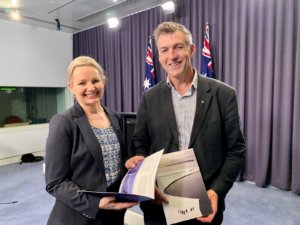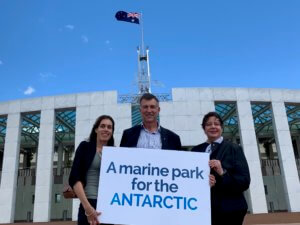Antarctic explorer and adventurer Tim Jarvis AM has issued a rallying cry to the world’s nations to create the world’s next marine park for the Antarctic. Jarvis has outlined the benefits of the marine park in a new report from the Australian Marine Conservation Society (AMCS).
Next week, the 25 nations which make up the Commission for the Conservation of Antarctic Marine Living Resources (CCAMLR) will meet in Hobart to consider a proposal by Australia, France and the EU for a new marine park in East Antarctica. The new report The East Antarctic Marine Park: Maintaining Australia’s Legacy puts the case for this globally important initiative.
“Australia has a long and proud connection to the Antarctic continent at key moments in history – playing a key role in the 1959 Antarctic Treaty that promised signatory nations would only use the region for peaceful and scientific purposes, the groundbreaking convention in 1982 to protect Antarctic marine life – not just oversee its exploitation, and then the mighty diplomatic feat by Australia and France that led to a ban on mining 30 years ago,” said Mr Jarvis.

The report lays out the benefits of protecting key breeding and feeding grounds for an amazing array of Antarctic marine life including Adelie and Emperor penguins, seals, whales and seabirds, with the proposed new marine park encompassing close to one million square kilometres – an area bigger than New South Wales.
Mr Jarvis said: “Antarctica is thought of as an untouched wilderness, but the reality is different. This is a place threatened by industrial fishing and the long reach of climate change that is warming the ocean waters putting more stress on this incredible place.”
“The declaration of the Antarctic’s Ross Sea Marine Park in 2016 showed what could be done in establishing the biggest marine park in the world – but still only about five per cent of the Southern Ocean is protected – it’s time to get this done.”
“With January 2020 marking the 200th anniversary of Antarctica’s first sighting, the creation of a ring of marine park protection right around the continent is long overdue. The spotlight is now on Australia and the nations of the world in their next big step in securing the future of the Antarctic: the creation of the proposed East Antarctic Marine Park.”

ENDS
Notes for editors:
- The Commission for the Conservation of Antarctic Marine Living Resources (CCAMLR) was established by international convention in 1982 with the objective of conserving Antarctic marine life.
- The proposed East Antarctic Marine Park is spread across three distinct coastal areas – known as MacRobertson, Drygalskia, and D’Urville Sea-Mertz – covering almost 1 million square kilometres.
- In 2016, CCAMLR create the 1.5 million km2 Ross Sea Marine Park in the Antarctic – the world’s largest marine park.
For information/comment contact Tim Norton on 0402 077 721